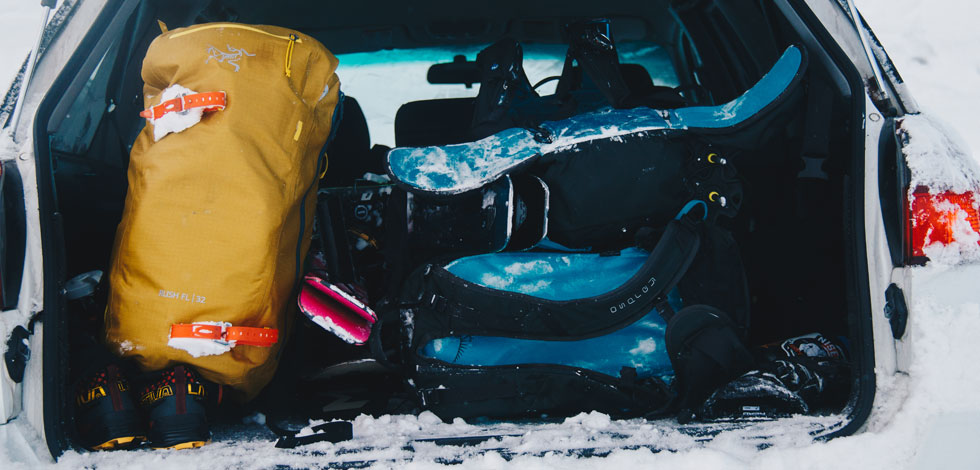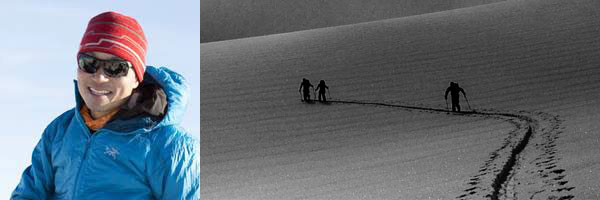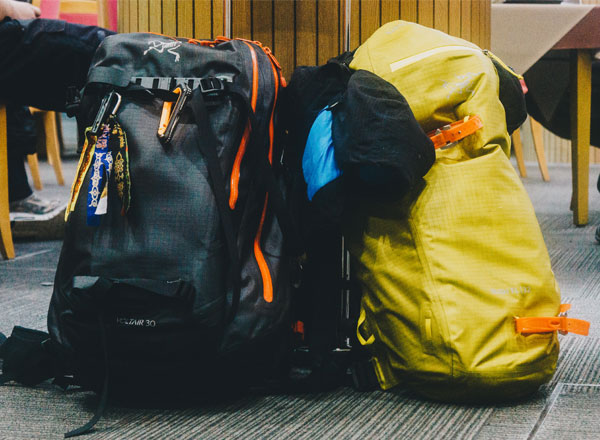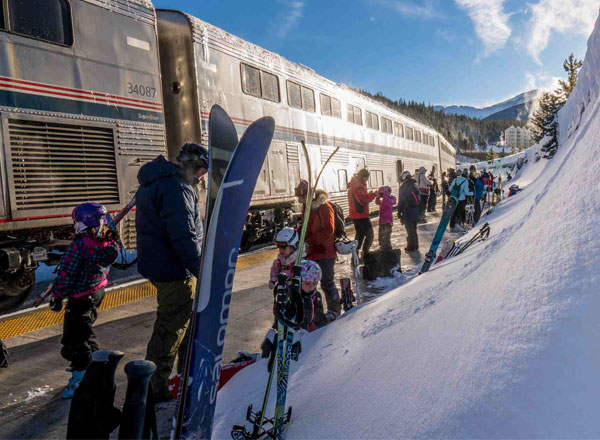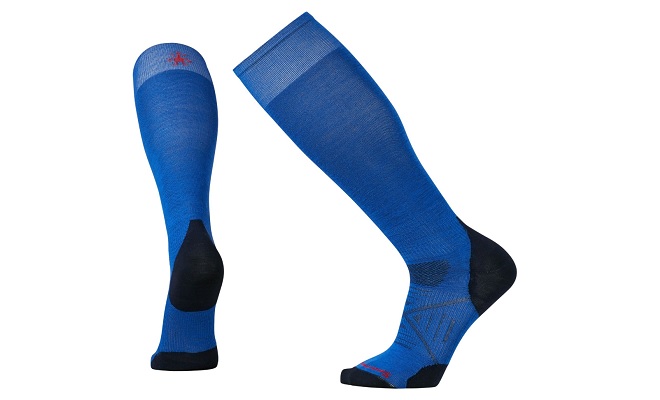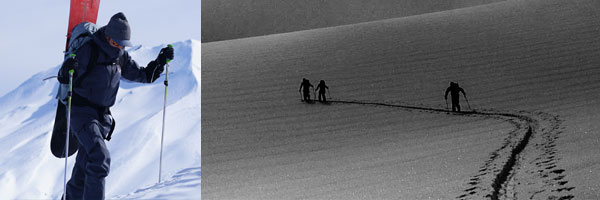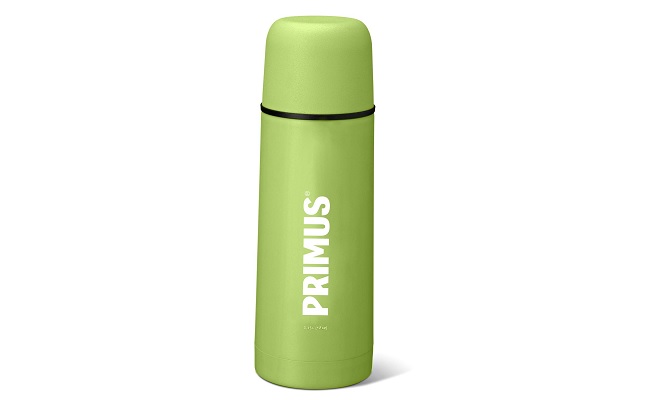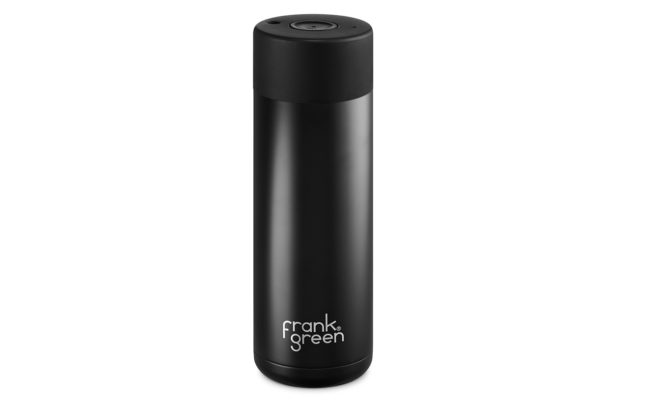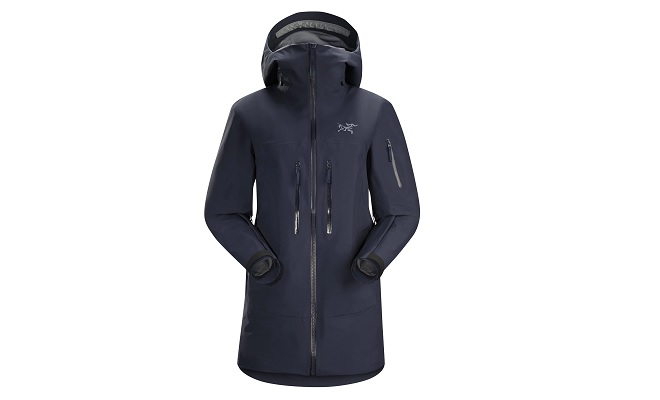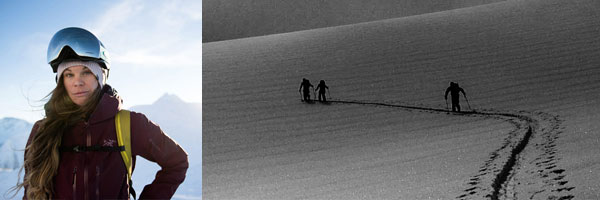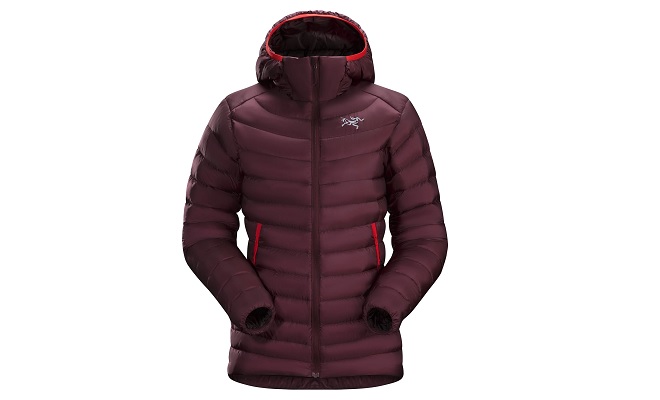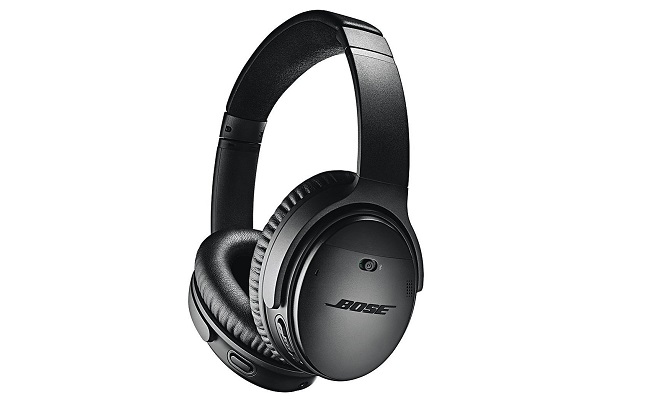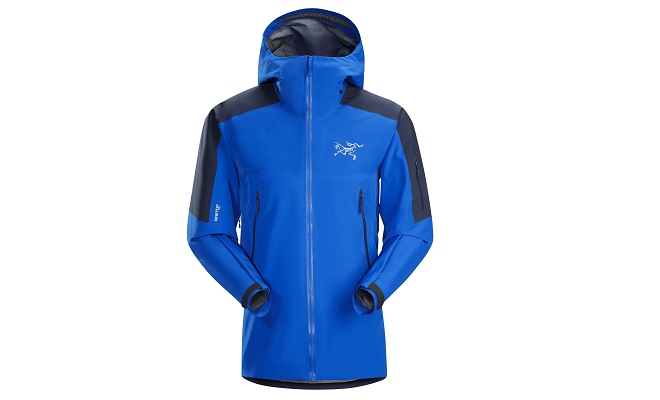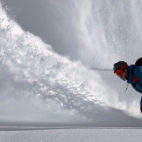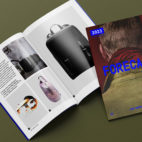The Ultimate Pro Guide to Traveling with Ski Gear
Traveling with ski gear can be tricky. It’s expensive, heavy and cumbersome. And only by clocking serious hours in transit can you really master the nuances of ski travel. That is, unless, you fly under the wing of a pro. Someone who’s not only clocked serious hours getting from A to B, but whose career actually requires it; trekking from mountain runs to runways are simply part of the job description.
And so we’ve teamed up with Canada’s outdoor giant, Arc’teryx, to ask their pro team of designers, product ninjas, and athletes to dish their tips, tricks and essentials in this ultimate guide to traveling with ski gear.
Pros
Sarah Wallace, Design Manager
Jonathon Wong, Product Line Manager
Christine Lustenberger, Athlete
Greg Hill, Athlete
Jonathon Wong, Product Line Manager of the White Line
Travel Tips
Carry-on your critical gear
The critical move when travelling to ski through airports is to carry-on your ski boots, orthotics, beacon, one set of gloves, ski socks, head lamp and some base layer with you. I’d add my contact lenses (since I can’t see well enough to ski without glasses and don’t want to ski with them), eyewear, camera + lenses and my computer (if I am on a work trip) to the mix. At least this way, if your luggage takes a detour, you can borrow some outerwear and some demos and rentals to get on the snow and you have all your critical personal gear. I’ve definitely seen people have these critical items (i.e. their boots) go astray in checked luggage and they get to sit and wait while everyone else goes skiing. The same applies to flying into huts on helicopters; definitely wear your ski boots so you know where they are.
Keep it tight and minimal
Try not to bring any extra bags that won’t double up on your trip. I usually bring a large day tripping backpack as my carry-on and put my boots and everything under the above paragraph into it. The f-stop bags work well since they have a zip-through back and you can stash your computer right behind this panel so you can take it through security separately. If you start packing extra bags in your checked luggage, your available volume will go down and your weight will ramp up into penalty land quickly. The same obviously applies to not doubling up on items (i.e. additional duplicate clothing layers, hats, etc.) or that weird camera lens you never use.
TSA: It’s handy to have a system
I’ve flown a fair amount for work so you do want to have a system where you can easily pop your laptop into the box for the X-ray machine and efficiently put it away on the other side without leaving expensive bits and pieces (i.e. your camera which can stay in your bag) all over the place while you get organized again. I have one system and I stick to it for all my trips; with ski gear or without.
In terms of protecting gear…
I usually strap my poles to the skis (so it’s harder to break them in transit), pad my bindings, tips, and ski tails with clothing (3 to 4 of those Voile/G3 ski straps are handy to keep everything in place) and then strap or lay objects like ice axes and avalanche probes parallel to the whole package in the same bag.
Some people like rolling ski bags (and I do recommend rolling duffles unless you need to put your luggage into a helicopter at your destination) but the combination of both will send you into overweight penalty land. Boot crampons and ski crampons can go with your skis or in your duffle bag (just pad them up to protect everything and don’t try to take any of this stuff in your carry-on!). Oh, and don’t forget your skins if you are going touring!
You’ll most likely get charged for extra baggage unless…
No matter what you do, you are probably going to get charged for at least your ski bag or perhaps more with most major airlines unless you have been fortunate enough to come by a business class ticket. The unusual exception to this is if you are a current or ex-Canadian service member (you need to obtain a CFOne card to prove your veteran status) in which case WestJet and Air Canada will allow you to bring three checked pieces of luggage with you at no charge. Is this applicable to other countries? I’m not sure. But it’s certainly worth investigating.
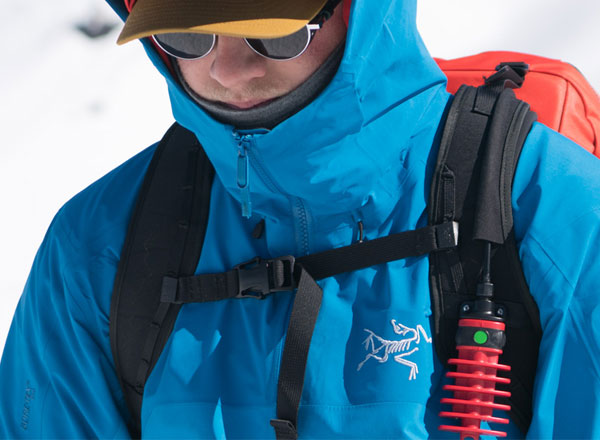
Flying with an airbag pack?
If you’re flying with an airbag, you can usually bring the decompressed cylinder (assuming it is the compressed air style) on as carry-on as long as the bottle is empty, disassembled and everything is in a zip lock for inspection. Although note, I have only done this through Denver airport so it might not go so smoothly in other places where they do not have a lot of experience with airbags. If you are using an ABS or a Scott Alpride, you will have to source those cartridges at your destination.
Flying in a helicopter or light plane?
If your gear is going to get flown into a hut or something similar by helicopter or light plane (i.e. if you’re flying into Smithers or Terrace and you’re going into the Burnie Hut) it’s better if you can break everything down into your daypack + several small (preferably waterproof) duffles or roll-tops. The latter are much easier to pack into the small luggage compartments on helicopters.
Catching trains
Travelling on European trains, particularly solo, can get rather tricky. The crux is moving your ski bag, rolling or other duffle and yourself onto the train and off again without losing anything. You can often find a ski rack on the bigger trains, where you can place your ski bag upright, and then place your luggage in one of the racks near the doors so you can easily get everything off at your destination. Give yourself some time, make sure you know when your stop is coming up and be prepared to move everything quickly. It’s obviously easier if you even have one extra travelling companion since you can bucket brigade all your gear on and off with one person on the platform.
Local commuter trains are very difficult to negotiate since they are intended for moving commuters, not travelling skiers. Prepare to get scowled at! I think the toughest train situation I dealt with was having to heave my ski gear on and off the London tube.
Three-day Eurail passes are handy, and economical, if you need to use the train for more than one journey. When I was on the Haute Route, the Swissrail folks would not let us send our luggage through to Chamonix (we were doing the Classic Reverse from Zermatt) without proof of ticketing and my three-day rail pass saved the day.
School holidays in Austria are crazy! Try to avoid these time periods. Your luggage will end up haphazardly stacked in the train corridor for sure under this scenario.
I never travel without…
My Scarpa ski boots (have basically used Maestrale RS and Alien variants since these boots came out), Intuition Pro Tour liners and my Kintec orthotics have all been carefully punched, molded, tweaked and customized, over the years, by Tom James at Intuition so those bits and pieces are basically mission critical deal breakers. I used to be a hardgoods buyer for MEC for 11 years so I have had my share of otherwise great days ruined by ill-fitting ski boots. I think I would lose my mind if I mislaid any of these bits and pieces before or on a trip!
Great ski socks are also really critical for skiing and touring and I currently use the really thin Smartwool PhD Ski Ultra Lights so I will put a set of these into my carry-on as well.
When I’m in travel (versus ski) mode, I usually pack a little pancake lens (a 40mm EF for my Canon 5D3 or a 20mm for my Panasonic GX1) and use it to shoot detail shots, candid portraits or anything else interesting. All this usually goes on a separate memory card (I have some high speed ones for actual ski photography) so I have a bunch of interesting non-ski photos to build out photo essays, etc.
Never ski without…
I’ve used BCA beacons since 2004 so the current BCA Tracker3 is something that I travel with and is my go-to beacon for any type of backcountry skiing.
Sarah Wallace, Design Manager of the White Line
Travel Tips
Dead Space
Many pieces of ski/snow equipment are “hollow” or have spaces inside them that can be utilized, like helmets and boots etc. Never leave these spaces empty! It’s surprising how many pairs of socks and underwear you can stuff inside a ski boot.
Layover Logic
When booking flights pay close attention to what’s happening with your layovers and flight connections. These can make or break your journey. Ideally you want layovers to be just long enough to minimize the risk of luggage not making the connection but short enough that you don’t have to bankrupt yourself spending hours at airport restaurants killing time.
Also, avoid airport changes at all cost. Years ago I was going on a snow trip in Argentina and inadvertently booked a flight itinerary which involved switching airports in Buenos Aires. Never again!
Book Ends
If you’re a book lover, audio books and podcasts on your phone are a great way to get your fix without using up any physical space that could otherwise be filled with ski essentials.
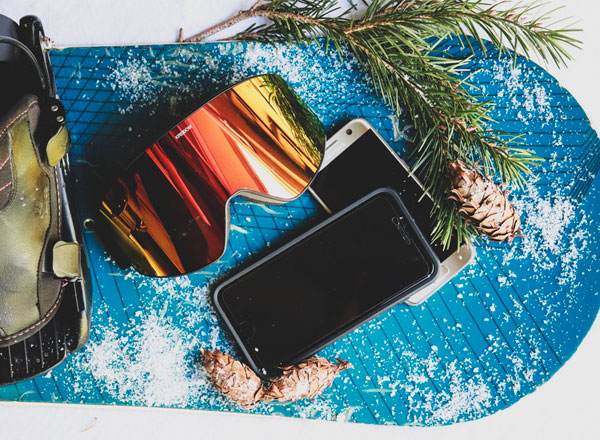
I never travel without…
As a tea lover a good thermos is critical! For years now I’ve been deeply attached to this Primus thermos and take it with me any time I go on a ski trip. The design is clean and simple, and the 350ml size is perfect for me. It’s comfortable to hold and fits more easily in a pack full of other essentials, compared to some of the larger sizes of thermos. When split boarding I often like to have cold water/drinks and a thermos of hot tea in my pack, so it’s nice to have a thermos that is on the smaller side.
Having said that, I was recently on a ski trip in Revelstoke and this caught my eye.
I love everything about this thermos and couldn’t say no. Beautifully designed, made of premium materials, and recyclable at end of life. At 595ml it’s a little bigger than the Primus so it’s hard to say which one will be my go-to going forward…will be nice to have both options!
There isn’t one particular lip balm that I can’t live without, but what I can say is that I need to have several on every ski trip. Lip balms are mandatory when you’re out in harsh conditions day after day, and they are one of those items that perpetually get misplaced. With millions of other things to think about, I don’t want to have to keep track of one solitary lip balm, so it’s nice to have a number of spares that you can distribute throughout various pockets in clothing and packs; that way you’re sure to always have one handy. Make sure they have a good SPF rating!
Dermatone Skin Protector “the frostbite fighter”. This is a must-have for preserving your delicate skin. Apply before and during your ski day. It’s a super small size and therefore great for traveling, but you don’t need to apply much so it lasts quite a long time. Added bonus – smells like coconut!
Never ski without…
Fall 2018 Sentinel LT Jacket…which has been a game changer for Arc’teryx. A progressively styled freeride shell with a long and lean youthful silhouette, bold, dynamic color blocking, and a full feature set. N80p Gore Tex with CKnit backer is tough and protective yet quiet and supple. This jacket was ‘my baby’…a personal mandate project that I was determined to bring to life, so naturally if I’m going on a snow trip I don’t want to leave home without it.
Christine Lustenberger, Athlete
Travel Tips
Wheels, every time
My ski bag is usually packed with rope, ice axes and all the other backcountry ski essentials, and there is no way I’m lifting it, so a ski roller bag is the way to go.
Double up
If you can find a great double ski bag, they’ve got great upside. Traveling with a friend? You can easily fit both your skis in one bag and use that extra $25 for some tasty food.
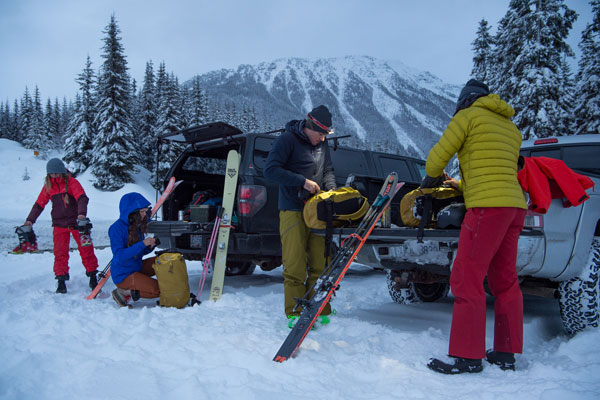
I Never Travel Without…
I always carry on a big wrap sweater and a pair of socks. Night flights are cold so it’s nice to wrap up and stay warm.
Never Ski Without…
The Cerium LT Hoody is a go-to. It’s light and packs small, so takes up minimal room in my pack. From keeping me warm on a ridgetop to walking around town, it’s the one thing I never leave at home.
Greg Hill, Athlete
Travel Tips
Strap in (and around)
Ski straps like the ones from Voile or similar ties are essential to keep your kit tight and protected from the inevitable jostling. Go with something that adds a little ‘buffer’ between your skis too, i.e. thick rubber or Velcro and foam, or strap some clothes or socks between.
Carry-on your boots, always
Carry on your ski boots. They’re the one thing that’s super tailored to the user. It’s a bummer when your gear doesn’t show up and you’re renting or using someone else’s gear. This way at least you have your own boots. And you can just rent or borrow the rest.
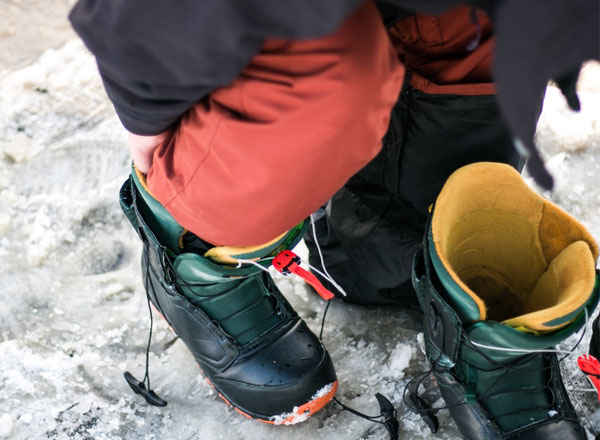
Never Travel Without…
Traveling with my Salomon S/LAB MTN ski boots in hand is key. Boots are essential and usually very much tailored to the rider. Skis and everything else are easily borrowed or rented if you’re unlucky enough to have them lost in transit.
When I fly I love my Bose QC35 noise-canceling earphones, they make the small planes easier to sleep and travel on. Cutting out all the extra noises that make flying harder on me. Mine also come in a handy traveling case that holds my passport and tickets.
Never Ski Without…
This is pretty easy. No matter the weather, hot or cold, I always need my Gore-Tex layer, my essential ski jacket. My favorite is the Arc’teryx Rush LT.
Different airlines, different rules
– Ski equipment checked in separately counts as one piece of checked luggage.
– One boot bag is allowed per passenger and doesn’t count as a piece of checked luggage if it only contains boots and is carried with skis or a snowboard.
– No extra charge to check skis or a snowboard when traveling between Canada and Europe, the Middle East and Africa. Fees may apply when traveling within Canada, between Canada and the U.S. and all other destinations.
– One or more sets of skis carried together in the same container count as one piece of checked luggage.
– You must pack skis and poles in a rigid and/or hardshell case designed for shipping.
– If carried separately, a set of ski poles count as one piece of checked luggage. No oversize charge applies to skis or snowboards, but overweight charges may apply.
– Ski equipment is a standard checked luggage item
– It’s included at no extra charge in the luggage allowance (excluding Light and Basic fare tickets) if it’s the only luggage being checked (or one out of the two pieces of luggage allowed for Business and La Première cabins).
– One piece of luggage includes either of the following: a pair of alpine or cross-country skis, a pair of poles, and a pair of boots; OR a snowboard and a pair of boots.
– Items must be stored in a travel case not exceeding 300 centimeters or 118 inches in length.
– Ski or snowboard boots can be packed in a separate bag
– The travel case and boot bag are together considered one standard checked luggage item and they’re included at no extra charge in the luggage allowance.
– Transporting a helmet in the cabin is considered a hand baggage item, not an accessory.
– Transporting an avalanche airbag requires prior approval and a request submitted at least 48 hours before departure
– Ski equipment counts as one piece of luggage toward baggage allowance. A fee applies to equipment over 50 pounds or 115 linear inches.
– One piece of luggage includes either a pair of skis with poles and one boot/helmet bag; OR a snowboard with a boot/helmet bag.
– If the boot/helmet bag contains clothing or additional items, standard checked baggage fees apply.
– Ski/snowboard equipment can exceed 62 linear inches but not over 115 linear inches or an oversize fee applies.
– Ski equipment is considered checked luggage with all applicable fees applied per person, per bag, per segment.
– Fess apply for bags weighing over 40 pounds and over 80 inches in size. No luggage weighing over 100 pounds is accepted.
– One piece of ski equipment includes either a pair of skis or a snowboard, a pair of poles and a pair of boots packed in an acceptable container.
– Ski equipment counts as a piece of checked luggage. If traveling on a hand baggage only fare, a fee will be charged to check ski equipment.
– Items weighing more than 23 kilograms may be charged an overweight baggage fee.
– Skis and snowboards must be packed in a relevant bag made for such equipment, measuring no longer than 190cm in length.
– Skis/snowboard and boots can be packed in the same checked baggage as clothes provided it doesn’t exceed 190 x 75 x 65cm (75 x 29.5 x 25.5in) and weighs no more than your weight allowance.
– If boots are packed separately from skis or a snowboard, the boot bag can be carried as cabin baggage providing it fits the hand-baggage gauge.
– Ski equipment counts as a piece of luggage toward luggage allowance.
– One piece of luggage includes a ski/pole bag and a boot bag OR one snowboard bag and a boot bag.
– Excess weight fees will apply if the combined weight of the ski/pole bag or snowboard bag and boot bag exceeds 50 pounds.
– If linear dimensions exceed 203 centimeters or 80 inches, excess size fees will apply.
– There is no extra charge for ski and snowboard equipment but one piece of equipment counts as checked luggage.
– Skis and snowboards are exempt from the standard size requirements of 62 inches but need to adhere to weight and other equipment guidelines. Passengers are charged an excess baggage fee if the snowboard exceeds the checked baggage weight requirements. Ski and snowboard equipment are not accepted on flights to/from the Dominican Republic.
– One piece of ski equipment includes either a pair of skis, a pair of poles and a pair of boots OR a snowboard and a pair of boots.
– If packing boots separately from skiing equipment, they must be in a ski or snowboard boot bag to be considered part of the one piece of checked luggage.
– Ski equipment counts as a piece of luggage toward luggage allowance.
– One piece of equipment includes a pair of skis or a snowboard, a set of poles and a pair of boots.
– The airline allows up to two bags (containing a set of skis, poles, and boots) to count as a single item, even if packed and tagged separately.
– Snow ski equipment is not subject to excess size charges but excess weight charges may apply if the equipment exceeds 50 pounds.
– Ski equipment is charged as a standard checked bag.
– If the equipment weighs over 18.1 kilograms or 40 pounds excess weight charges will apply.
– If it measures more than 62 inches / 157.48cm then oversize fees will apply.
– If traveling with skis or a snowboard you will need to sign a limited liability release form.
– A piece of ski equipment includes a pair of skis or a snowboard, a set of poles and a pair of boots.
– Ski equipment counts as a piece of checked luggage.
– One piece of ski or snowboard equipment can be checked per person. One piece of equipment includes up to two snowboards in a bag plus a boot bag OR up to two pairs of skis and associated equipment in one bag plus a boot bag.
– Overweight fees will apply if the combined weight of the ski bag and boot bag is over 50 pounds (23 kg).
– A boot bag without an accompanying ski bag is considered one bag, with applicable baggage fees.
– Ski and boot bags that contain other items in addition to or in place of appropriate ski equipment are subject to the applicable overweight checked baggage service charge.
– Ski equipment is transported as part of your checked luggage allowance as long as it doesn’t exceed 23kg.
– A piece of ski equipment includes a pair of skis, poles, a mask or helmet and a pair of boots. Snowboard equipment includes a snowboard, a helmet and a pair of boots and bindings.
– You are not allowed to take both sets of ski snowboard gear as part of your luggage allowance; it’s one or the other.
Liked this article? You might enjoy these too:
How to Fly With a Bike: 8 Things to Know
Packing List :: Adventure Bikepacking
The Best Backpacks for One-Bag Travel
The Best Snowboarding and Ski Backpacks of 2017
Feature image by @chilledmoose





 Carry Awards
Carry Awards Insights
Insights Liking
Liking Projects
Projects Interviews
Interviews
